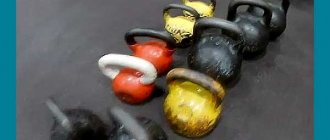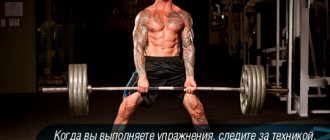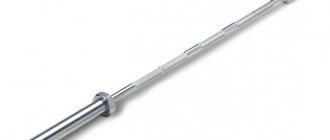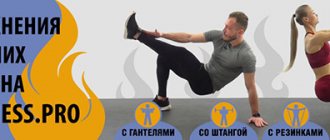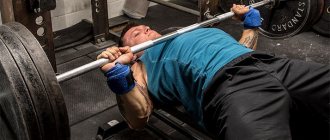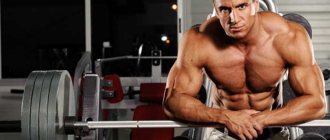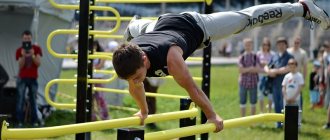Training for MMA fighters is a set of exercises with specific loads similar to those that a fighter will endure during sparring. Translated from English, MMA (Mixed martial arts) means “mixed martial arts.”
Let's look at the exercises that MMA fighters use to prepare for a fight. This article contains materials with recommendations from experienced athletes. It is not difficult to follow the advice of the masters; following their recommendations will shorten the path to a successful fight.
The set of exercises is aimed at developing explosive strength, endurance and skills that will be used by the athlete in the process of fighting in the art of mixed martial arts.
Both the fighter and the UFC coach must carefully analyze all actions before developing a complex so that each round is winning.
Recommendations from experienced athletes
Swede Alexander Gustafsson and British fighter Tom Watson shared the secrets of their training for MMA fighters.
Strength training consists of the following principles:
- Load on all muscles of the body. In mixed martial arts, the principle of destroying the enemy always works. In such a “meat grinder”, each muscle must show its strength. Fighter Tom Watson believes that gymnastics rings are better suited for this. Not all athletes who can bench press train with gymnastics rings. These exercises work even those muscles that the fighter is not even aware of. If there are no rings in the gym, perform push-ups with support from the TRX loop.
- Visiting the pool after training. Water helps remove breakdown products faster. Swimming is the safest sport for the spine; it is the best way to relax your muscles after working out in the gym. Gustafsson recommends swimming 200 meters first, followed by 4 sets of 30-second stretches for the hamstrings. Afterwards, run for a couple of minutes, standing in chest-deep water, then for one minute do shin overlapping and hip extensions, twisting in the water. This promotes the rapid removal of waste products from the muscles. Recovery after training is faster.
- Simple food. Tom Watson recommends eating a lot of vegetables and a little less meat. When cooking, use a minimum amount of ingredients and create a simple menu. Of the approved sports supplements, the fighter prefers products with a simple composition. He uses them throughout the day as needed.
- Weight control. Athletes lose weight before a fight. To move to other weight categories of martial arts, they recruit. In preparation for a fight, Gustafson loses up to 14 kg of his own weight so that his body weight does not exceed 100 kg. The athlete has his own secret to losing weight - almond oil. 2 - 3 spoons in the morning, during the day before meals and in the evening before bed will provide the body with the required amount of calories and maintain shape. Muscle mass will not be affected when losing weight.
- Using simple training methods. Professional mixed martial arts fighters do not use special myostimulation suits. Tom Watson recommends three basic exercises: the clean and jerk, the snatch, and the clean. The athlete prefers light programs and claims that classic weightlifting exercises are more effective.
Basic rules of strength training for developing strength and speed
- Do a variety of exercises, even use ones you don't like.
- Before working with heavy weights, you need to warm up your muscles well with light weights.
- When working with weights, use cheating.
- When lifting weights at an explosive pace, always use decent weights, approximately 70% of your one-rep max (this is the weight at which you can only do 1 repetition and no more.)
- All exercises are performed at a fast pace.
Strength training for fighters manifests itself in the mistake that many use the same type of exercises, without thinking about the fact that our body gets used to the loads, and this is a brake on the growth of results, so you need to add variety to the exercises.
Three types of training for MMA fighters
These sets of exercises are known and actively used by different schools of hand-to-hand combat. Athletes train in the gym under the supervision of a coach. After a year of classes, students train for wrestling and significantly increase the speed of their movements. The program contains a set of exercises:
- “Explosive” techniques with sports equipment – jerks, pushes. Over time, the fighter's movement speed increases.
- Stretching muscles using weights. Heavy projectiles increase the load.
- Support weight with legs or arms. The exercise helps strengthen the muscles that support the legs or arms during impact.
A set of exercises for strength and speed
These exercises are used by many MMA fighters, you too should use them, and later compare the results:
Workout #1
Muscle stretching for 10-15 minutes
- Dumbbell Bench Press – 6 sets x 15,12,10,8,6,4 reps
- Incline Bench Press – 3 sets x 10 reps
- Dips – 3 sets x 10 reps
- Barbell Hip Raise - 3 sets x 10 reps
- Military Press - 3 sets x 10 reps
- Raising the torso – 2 sets x maximum
Rest between repetitions for 2-3 minutes, do not forget to breathe correctly - exhale as you force, inhale as you relax.
Workout #2
Stretching for 10-15 minutes
- Deadlift - 3 sets x 10 reps
- Pull-ups - 3 sets x 10 reps
- Bent-over dumbbell rows - 3 sets x 10 reps
- Standing barbell curl - 3 sets x 10 reps
- Bent-over dumbbell raises - 3 sets x 10 reps
- Hanging leg raises - 2 sets x maximum
Workout #3
Stretching for 10-15 minutes
- Leg press - 3 sets x 10 reps
- Lying leg curls in the simulator - 3 sets x 10 reps
- Standing calf raises - 3 sets x 10 reps
- Lunge Snatch - 3 sets x 10 reps
- Jackknife exercise - 2 sets x maximum
Subscribe to groups on social networks (VKontakte, Odnoklassniki, Facebook, Twitter), it’s very easy to find us, just write BOMB BODY in the search for the desired group!
Hand-to-hand combat techniques
The most popular and simplest, in terms of technique, is hand-to-hand combat. In order to master self-defense techniques, you do not need a 180-degree split or any other superpowers.
For beginners, it is enough to have fists that are ready at any moment to repel the attacks of an attacker. Traditional in everyday life is a direct blow.
Punching your opponent in the nose, jaw or eye will help you gain an advantage in a surprise fight and will give you enough time to escape from the enemy's sight.
If you have never fought before, these types of blows can seriously injure your hand. Therefore, it is more correct to hit with an open palm. This way, you have a greater chance of causing serious injury to your ill-wisher rather than to yourself.
Another popular technique is the uppercut - an upward punch to the opponent's jaw. Its advantage is that it is much more powerful than a direct blow and is capable of knocking out an enemy.
Karate techniques
The most complex and professional style is karate. It will take more than one day or even a week to learn its techniques.
If you decide to become Bruce Lee at home, mentally prepare for daily and intensive training.
This type of martial arts is similar to kickboxing and emphasizes life-threatening kicks.
The stages of learning occur from the bottom up in the truest sense. First, hone your skills while sitting on the floor, striking back and forth with the ball of your toes and the edge of your foot. Below is an illustration of the fundamental techniques.
- kick to the side - eko-geri;
- back kick - ushiro-geri;
- hitting with the forearm from the inside out - uchi-uke.
Working on striking technique
A correctly placed blow is the key to a successful end to the fight. But in order for it to be executed correctly, it is necessary to regularly develop single variations and combinations.
MMA striking training includes work on the “paws”, on the bag, practicing strikes with. In this case, it is advisable to pay attention not only to attack, but to defense and counterattack.
At home, the most suitable option for practicing strikes would be the so-called “shadow boxing”. This type of training involves striking in the air, the main task of which is to master the technical elements of attack and defense without involving a real partner for help. Working in this way, the fighter thinks through various options for technical actions that he will carry out in a real fight. All movements should be strived to be performed with maximum speed and explosion, which increases the actual speed of strikes in battle, as well as the maneuverability of the athlete himself. At the same time, when conducting rounds of such a fight with a virtual opponent, you can use weights - small dumbbells or other weights. Their use allows you to achieve the desired effect somewhat faster.
However, quite often it is important to strike in the air at a slow pace. Due to this, you can quickly identify existing flaws in the technique, determine the degree of your stability, understand the reasons for the imbalance, and master new techniques. In addition, “shadow boxing” allows you to choose a strategy for the upcoming fight if the athlete plans to compete in an amateur or professional tournament.
It is also important to pay attention to proper breathing, since the final result of the fight, his health and well-being depend on how easily and naturally a fighter breathes.
In this article we will tell you how to learn to fight, since in modern conditions such a skill is useful not only for a man, but also for a fragile girl.
, which may find itself in a difficult situation.
Each of us at least once in our lives has had to deal with attacks of open aggression from another person. Even if you are a non-conflict person, remember that anyone can become a victim of inappropriate behavior of others. Very often, teenagers find themselves in such situations who, in the opinion of the attacker, are not able to defend themselves on their own. In this regard, every boy, perhaps, wondered: “How to learn to fight?”
Of course, for this you should have the appropriate physical preparation and psychological attitude. We are not saying that you need to get into a fight in response to any remark from the offender. On the contrary, strength of character
manifests itself
in those cases when you can resolve a conflict peacefully and not start a fight at all.
However, it is still better to be able to protect yourself and your loved ones in any situation. Before you master the necessary techniques, realize that it is simply impossible to learn how to fight in one day, tune in to regular training
and periodic physical activity, and be prepared for possible bruises and abrasions.
The main assistants in mastering self-defense skills are endurance, strength and speed of reaction.
. After all, learning to fight is half the battle; it is also important to avoid blows correctly and quickly. To master this skill you will need a potential opponent, so it is best to turn to a professional in this case. In the hall you will be taught not only how to fight like a ninja or like a special forces force, but will also be told in detail what pain points are present on the enemy’s body, what methods of psychological influence are the most effective, etc. Agree, having such an advantage, you will be able to fight much better and hit your opponent much faster, while avoiding serious consequences, both for yourself and for him.
It happens that there is simply no opportunity to work with a trainer. However, do not despair, you can learn to fight on your own.
. We will talk about basic skills in this subsection, and also demonstrate several visual exercises.
Agree, any of us can meet a person on the street who, to put it mildly, will be unfriendly. Before you start training at home, watch a few video tutorials
given below.
And most importantly, remember that the willingness to respond blow to blow should be your main assistant.
What can save you is not technique, not style, or even excellent knowledge of wrestling, but control of yourself and your body. Even if you have not yet mastered any technique, remember the basic techniques of street fighting
and use them when necessary.
- Knee your opponent in the groin.
- Point the phalanges of your fingers directly at your opponent's eyes and press hard.
- Hit your Adam's apple with your fist.
- Use available tools: keys, phone, lighter.
Yes, some would call it " dirty tricks"
“, but sometimes in a street fight the main thing is to survive or get as few injuries as possible, and sometimes there may be several attackers, so these techniques can be extremely effective.
If it is still difficult for you to learn how to learn to fight at home, then it is better to go to the gym with one of the trainers in some direction close to you.
Working with your own weight
It's no secret that absolutely any MMA training necessarily involves the body. There is no need to “reinvent the wheel” here, and one should adhere to the concept of the fight stated above. To this end, we pay special attention to push-ups, squats, lunges, pull-ups, and practicing the “bear walk.” The ideal option is to combine all these components into a single system and perform them both with and without pauses. Such trainings are ideal if you plan to train an MMA fighter at home. The main advantages of such loads are that they do not require special sports equipment, and there is also no connection to the location and time of classes.
